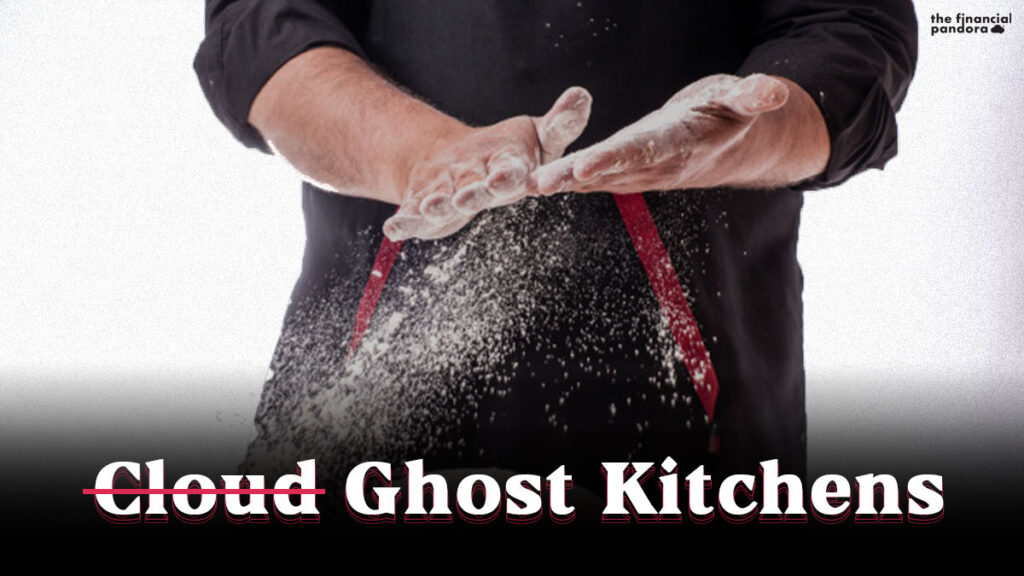What is a Ghost Kitchen?
“Zomato Co-founder and CEO Deepinder Goyal said in a series of tweets on Friday that the Company recorded 60% higher sales on December 31 over the previous New Year’s Eve.” – The Economic Times, 1st January 2021. Thanks to all the youngsters staying in on New Year’s Eve, amidst the pandemic. With the hard liquid and the red paper glasses, Spotify music, and the edibles coming in, we all had a good time. The only problem with that was, a lot of us ordered from Ghost Kitchens, probably even without knowing that that restaurant was merely but a Ghost. A funny name given to Cloud Kitchens, huh?
These restaurants work on a delivery-only model, with no sitting area, no waiters, no fancy lighting, no fake smiles, and no sweet talk with the chef. They save on a lot of rent this way, have an electrical kitchen set up in a tiny space somewhere in the area, and could thus focus their attention on drastically improving the food quality. But, only if this was their Business Vision.
How do these businesses operate?
The truth, on the other hand, is that almost 90% of these Cloud Kitchens order packaged foods, heat them as soon as they receive an order, and send it out for delivery. That’s why you get the food delivered so fast. There are reports that a lot of the big fast food joints, use month old products and sell it to their customers. No, we are not just talking about ready to eat French fries, chips, and dairy items. Whatever you can think of to eat can apparently be available in a ready to eat form. Gujarati dal, baigan bharta, bhindi masala, chole, dal makhani, aloo matar, dum aloo, butter chicken, and even malai kofta ; can all be frozen and stored for months altogether. I was startled to know that some cake shops buy Frozen Cakes instead of having their chefs make it to order! And trust me, you won’t even realize the difference. The sad part about this is, we idealize a weekend long party with friends, hogging on burgers, cheese and drinks, without even questioning the quality of ingredients that we are indirectly paying for.
Pehle pehle pal kitne khaas hote hai..
The Virtual Kitchen segment has only recently started to take shape. Infact, the lockdown is the perfect blend of opportunities for this segment to reach new heights. Delivery on the Internet had started to take shape in 2013, Faasos sowing the seeds for its development. We have all ordered from Faasos, right? There was never a restaurant named ‘Faasos’ in our locality. Sure, there were outlets for takeaways, but we hardly saw any seating arrangement and yet we trusted their food quality. ‘Trust’ is the only and the most important boat, that lets this industry float. One negative review on social media, and the mere existence of the seller could be questioned. Jaydeep Barman wanted to build another Domino’s, but for Biryani. Back in 2017, they were selling 7000 biryanis a day. They used the same kitchen, common ingredients and the same staff to fulfil orders for different brands. They also have another venture by the name of Behrouz Biryani. Their website claims that Behrouz is a legendary mythical kingdom, set to highlight the lipsmaking recipes made with secret Indian spices, giving people the absolute royal feel. This recipe was believed to have been lost forever, but was later discovered from the ruins of the place by King Cyrus. Whether believable or not, I believe that this was marketing at its finest.
Are foreign players eyeing the industry too?
For the longest time, Mr. Jaydeep had the absolute advantage of being the only man standing in this industry that he had newly discovered in India. During the same time however, this segment was far more developed in the foreign lands. Seeing the growth opportunities in India, foreign players have now started eying the Indian Market. A Ohio based burger maker, Wendy’s, that already has 9 restaurants in India, has partnered with Rebel Foods to open 250 cloud kitchens in India. It plans to have more than 150 physical outlets over the next decade. Since the market has just begun to expand, we have companies entering with great swing, trying to get as much of the market share that they can.
Do you know that DIYs are trending?
We Indians don’t take competition lightly, do we? Ever heard of DIY Food kits? As per a Vogue article, the DIY trend is here to stay, with more and more delivery kitchens adding DIY meals to their menus. So what exactly is a DIY box ? A very interesting concept, this kit comes with pre portioned ingredients that help the buyers recreate a restaurant quality meal at home. So, now you can cook a gourmet meal at home without having to shop for each ingredient separately. Apparently, some restaurants are also delivering their signature sauces so that people can experience and enjoy the exact same flavors right from the comfort of their homes. This technique ensures that the food is delivered safely in air tight containers, taking the wastage to a minimum. This reminds me of a brilliant marketing gimmick. Back in the days, women would take more than a day to bake a cake for their family members. They did this gladly, because they loved taking the effort to make something memorable for their loved ones. A company thought that the long cooking hours were a problem for the ladies and hence came up with a ready mix for the batter that reduced the cooking time to 50% of the original. Ironically, to their surprise, this product was not very well accepted by the public. On researching and involving experts, they realized that the women considered the ready mix to be an insult to their efforts. The company then decided to launch a new product – this time giving the women more tasks to complete the baking process. Their sales sky rocketed and they understood the human psychology of product purchasing.
DIY kits, on the same lines, add fun to the food making process, are easy to follow and give a sense of accomplishment. “ Be a chef in just Rs.109” – this is the tagline of a DIY Kit startup, Being Chef. It lets you cook exotic dishes in less than 5 minutes. A substitute for Maggi? Maybe. The future of the food industry? Maybe.
Bhaiya, 1kg butter chicken doge kya?
Indians are famous worldwide for their intellect, passion for food and innovation. Ever thought of ordering food by kilograms? This online startup, MeatStockExchange has made it extremely easy now. It’s website says, ” We are also probably the only player in the online space where “By KG” as a concept has been replicated for raw, semi cooked and even for complete range of cooked food for your home or on days where you have larger gatherings.” They keep varying the prices regularly on the basis of demand, ensuring that the price benefit is passed onto the consumers.
Don’t want to order bulk food? Alright. What about ‘Ma ke Haath ka Khaana’ ? Homely is evolving as a community. This is a brand that calls their chefs “Yummakers”, regularly audits their premises and keeps an eye on where they buy their raw materials from. This can get you Neer Dosa from a South Indian, Dal Pakwan from a Sindhi or Dal Bati Churma from a Rajasthani – couldn’t get better right? They work on a slightly different model as compared to the others. They don’t believe in mass production, but instead focus on quality. They contact around 10 – 15 homemakers in a locality and get the food delivered directly from their houses, instead of having to first accumulate it in one central kitchen. The startup idea was not to have another restaurant – but to connect them all together, have an asset light model.
Selling food, the Ola way
This too reminds me of an off – beat example. The pioneer in the asset light model segment is Ola Cabs. Back in 2004, when the founder Bhavish Aggarwal was looking for an investor, no one was willing to invest. Meru had already taken over the market, and nonetheless, there were taxi drivers always available on the roads. A guy named Rehan Yar Khan collected money from his family and friends and decided to invest in Ola. His one lakh dollars turned to seventy five million, giving him a 1000x return. Rehan’s book – ‘Make your own luck’ tells this story. In December 2017, Ola decided to re enter the food delivery space and acquired the Indian business of Foodpanda. To set up a food business, two things are required – a kitchen and an app with a huge amount of traffic. They had both, they believed. Ola started building it’s own brands- Lovemade and Grandma’s kitchen, to name a few. Foodpanda began selling really cheap. I remember how everyday in office we ordered ice cream and shakes for as low as Rs.30. Foodpanda is believed to have shut down its operations in 2019. Learning from that, now, Ola’s food business is on the rise. It launched 3 new brands in the past year. It now competes with Lunchbox, Freshmenu, Faasos and Box8.
Ola is not the only player to have entered different industries. OYO Rooms is looking to enter the ready-to-eat food sector, an addition to its existing cloud kitchen network. In February 2019, OYO opened around 20 Cloud Kitchens. In the same year, OYO launched The French Press in Delhi and Bengaluru. According to an OYO spokesperson, over 25% of their revenue comes from the kitchens they operate in full service hotels. The onset of the pandemic impacted it’s main business operations drastically, and it also began struggling with the Cloud Kitchen segment. This forced it to experiment with the ready to eat food sector.
As the pandemic is here to stay for a while now, we hope people order food after doing a complete background check. Eat safe, stay safe! Hoping for a better 2021!
Follow Us @




